Which Bottled Water Is Best?
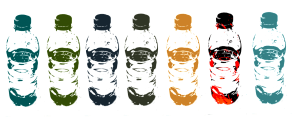 Whether you like still water, mineral water, enhanced water, or plain old tap water, today, we are testing them all in our ultimate bottled water test. We found everything from pH-balanced water, boxed water, ozone enhanced water, and hydrogen infused water. While we cannot back up any of the supposed health claims of some of the bottled water, what we can do is test the composition of the bottled water and help you to understand the different qualities of the various water options out there.
Whether you like still water, mineral water, enhanced water, or plain old tap water, today, we are testing them all in our ultimate bottled water test. We found everything from pH-balanced water, boxed water, ozone enhanced water, and hydrogen infused water. While we cannot back up any of the supposed health claims of some of the bottled water, what we can do is test the composition of the bottled water and help you to understand the different qualities of the various water options out there.
Spring Water and Artisan Water
The most common bottled waters that we found at local grocery stores were spring water and artisan water. Almost all of these bottled waters come from underground aquifers. Artesian water is tapped through a well. Spring water is collected as it flows up to the surface. It can also be sourced through a borehole. Depending on the brand, they may or may not undergo filtering or treatment.
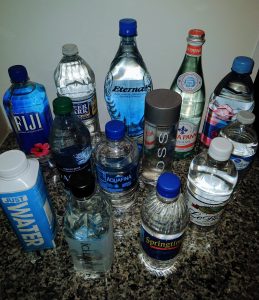
Sparkling Water
We tested two varieties of sparkling bottled water. Both brands that we tested are carbonated after sourcing. The Mountain Valley is a spring water and San Pellgrino is a mineral water. In order for a water to be classified as mineral water, it has to meet certain specifications. Mineral water must be naturally sourced and contain 250 or more parts per million of total dissolved solids.
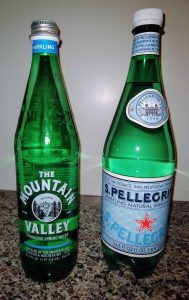
Reverse Osmosis
Another popular bottled water option was purified water. This water could be from any number of sources. Most often, it is simply municipal water that has been specially filtered or treated. The only filtration method that was listed on the water we purchased was reverse osmosis or RO. This is a method of purifying water by using pressure to push it through a semi-permeable membrane. The membrane acts as a filter, trapping unwanted particulate. Reverse osmosis leaves you with demineralize and deionized water.
Vapor Distillation
We also noted that some of the electrolyte bottled waters we purchased were purified by vapor distillation. Mass produced distilled water is typically made in a multiple-effect vapor compression distiller. These industrial distillers use large-scale boiling chambers that are connected by tubes to turn the water into steam. Then a compressor condenses the steam back to water and releases it into storage chambers. Because the contaminants and minerals are not affected by the temperature it takes to boil water, they are left behind. At the end of the processing, you are left with purified water.
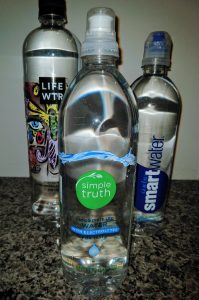
Infused Water
One of the popular trends we noticed was infused bottled water. We don’t mean flavor infused. These were serious infusions like electrolytes, ozone, and hydrogen. Each came with its own set of health claims. Some brands advertise that the electrolytes improve the taste of the water, while others claim that the added salts can improve athletic performance. Yet another brand claims that adding ozone to their water makes it the cleanest and safest water you can buy. We also read claims that adding hydrogen to water could boost your endurance, reduce fatigue, and minimize lactic acid. Like we said, we not going to test these health claims of these bottled waters, so believe what you will.
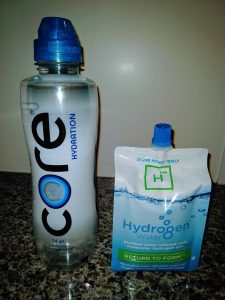
Taste
One of the reasons people give for drinking bottled water is that they prefer how it tastes. The source of the water and the way it is treated can affect the way it tastes. The type and amount of minerals in the water can also have an effect on the taste. Bottled water that is purified or treated has a more consistent taste. Bottled water that comes from a ground source can taste different depending on the day it was sourced. Tap water must travel a long distance through various plumbing systems from the source to the faucet. As a result, the taste of tap water can be very inconsistent.
A common complaint about tap water is the odor and taste of chlorine used for disinfection. Chlorination is an inexpensive and effective way to treat water, but the taste can be off-putting. Bottled water manufacturers typically take extra measures to improve the flavor of their waters by using extra filtration and adding a blend of minerals and salts.
The Lineup
We tested samples from twenty different bottled waters purchased at local grocery stores. We also performed the same tests on a sample of tap water. Many people question if bottled water is actually better than tap water. We wanted to put our city water to the test. Temperature should not impact the tests, but all samples tested were at room temperature.
| Brand | Type | Notes | Taste | Added Ingredients |
|---|---|---|---|---|
| Aqua Panna | Spring Water | Source: Aqua Panna, Italy Glass bottle | Light and slightly sweet | |
| Aquafina | Pure Water | Purified by reverse osmosis | Plain | |
| Core Hydration | pH Balanced Water | pH balanced water (7.4) with electrolytes and minerals | Salty, chemical taste | Calcium Chloride, Magnesium Chloride, Potassium Bicarbonate |
| Dasani | Purified Water | Purified with minerals | Slightly sweet | Magnesium Sulfate, Potassium Chloride, Salt |
| Deer Park | Spring Water | Multiple sources in FL | Plain | |
| Eternal | Spring Water | Source: Smokey Mountains, TN Naturally balanced water | Plain | |
| Evian | Spring Water | Source: French Alps | Minerally | |
| Fiji | Artesian Water | Source: Fiji Isalands | Slightly sweet | |
| Hydrogen Water | Purified Water with Hydrogen Gas | Purified water infused with molecular hydrogen gas A bit of a challenge to open and pour without spilling Claims to boost endurance and boost health Should drink within 30 minutes of opening | Clean, crisp taste with a slight aftertaste | Molecular hydrogen gas |
| Icelandic Glacial | Spring Water | Source: Iceland Bottled designed to look like an iceberg | Leaves an aftertaste | |
| Just Water | Spring Water | Source: Glens Falls, NY Boxed water, paper bottle The focus is on a sustainable bottle not the water, good for environmentalists | Plain | |
| Kroger Private Label | Purified Water | Store-brand water | Slighty sweet | |
| Le Bleu | Pure Water | Processed by fractional vapor compression distillation Oxygenated with ozone | Tastes like plastic | |
| LifeWTR | Purified Electrolyte Water | Purified by reverse osmosis | Chalky | Magnesium Sulfate, Potassium Bicarbonate |
| San Pellegrino | Sparkling Mineral Water | Source: San Pellegrino, Italy | Very tart | |
| Simple Truth | Distilled Electrolyte Water | Vapor distilled | Slight plasticy, chalky taste | Calcium Chloride, Magnesium Chloride, Potassium Bicarbonate |
| Smart Water | Distilled Electrolyte Water | Vapor distilled | Sweet | Calcium Chloride, Magnesium Chloride, Potassium Bicarbonate |
| Spring Time | Artesian Water | Source: Appalacian Foothills | Plain | |
| The Mountain Valley | Sparkling Spring Water | Source: Ouachita Mountains Glass bottle | Tart | |
| Voss | Artesian Water | No specific source listed other than "water from Norway" | Plain | |
| Tap Water | Municipal Water | Source: kitchen sink Slight sulfur smell | Metallic |
Our Tests
The tests kits and meters we used to compare bottled waters were from TestAssured and are available from their online store. These kits are a great home testing option. You can easily perform the tests on a variety of waters without having to mix messy solutions or mail away samples. The testing process is simple and the strips develop quickly, providing easy to read results.
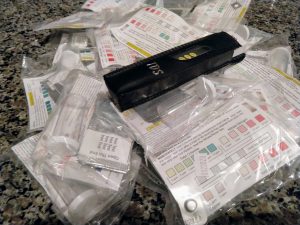
Chlorine, Copper, Nitrates, and Nitrites
The first set of tests were for common water contaminants. This included chlorine, copper, nitrates, and nitrites.
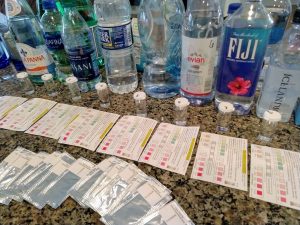
Chlorine can safely be added to water as a disinfectant. At levels higher than 4 parts per million, there is potential for negative health effects. Excessive amounts of chlorine in your water could cause an increased risk of cancer, asthma, and heart problems.
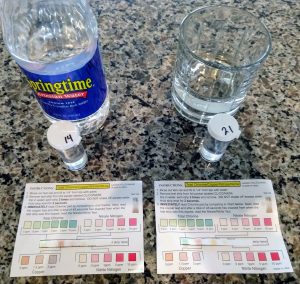
Copper can leach into water supplies through rocks, soil, and copper piping. Copper in drinking water should be at a level below 1,300 parts per billion. People who have high levels of copper can suffer from gastrointestinal issues. Research also shows that high copper levels may be linked to liver damage and kidney disease.
Nitrates and nitrites are found in soil fertilizers and can sometimes contaminate drinking supplies. Shallow and poorly constructed wells are highly susceptible. The EPA recommends nitrate levels under 10 parts per million and nitrite levels under 1 part per million for safe drinking water. Higher levels can result in developmental issues, blood disorders, and possibly cancer.
The results for these tests were not surprising. This is because bottled water companies often take extra measures to ensure the quality and purity of their water. Almost all of the waters had zero levels of these impurities. There were a few exceptions though, particularly tap water which had high levels of chlorine and nitrates.
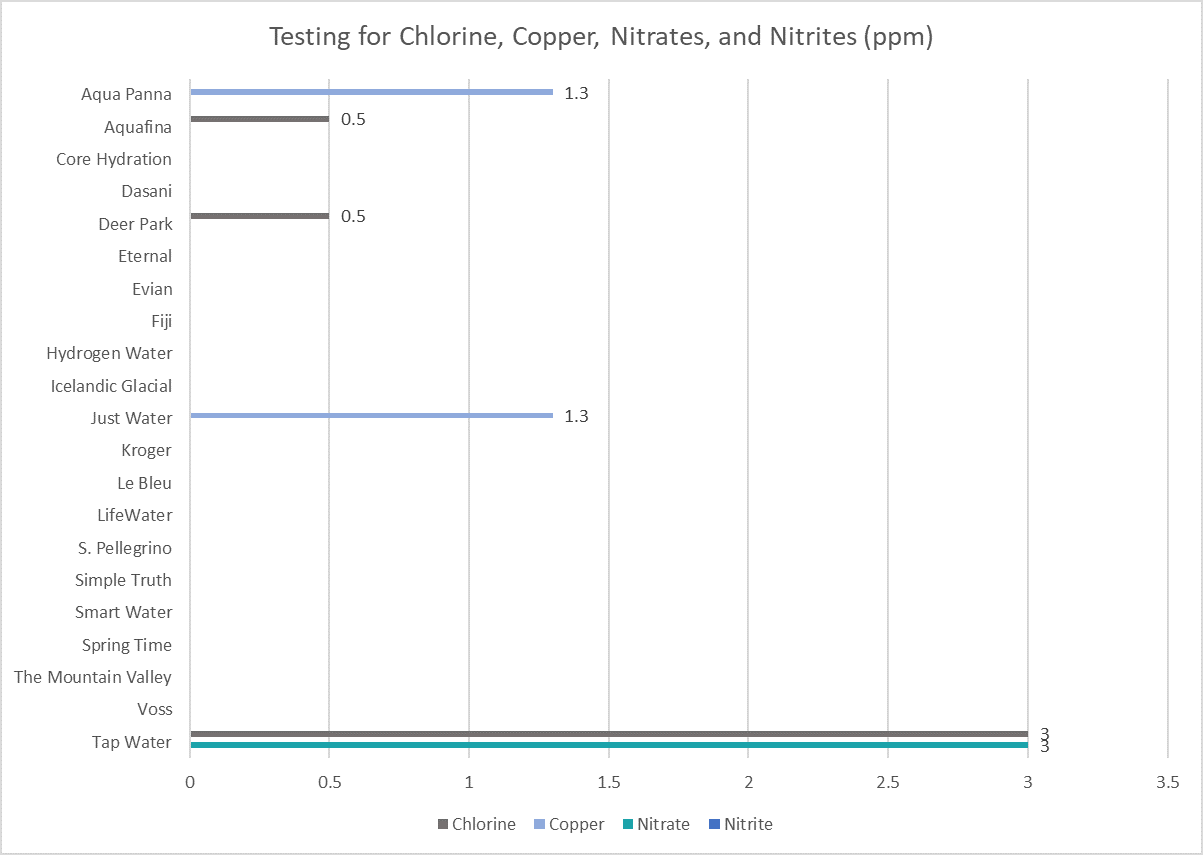
Alkalinity, pH, Hardness, and Iron
The next set of tests revealed more about the quality of the bottled water. These provided much more interesting results. Here we tested for alkalinity, pH, hardness, and iron.
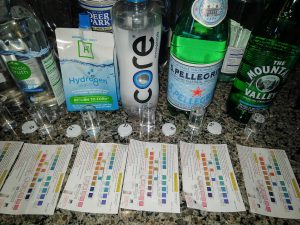
Alkalinity refers to the ability of water to neutralize acid. The alkalinity of a water source is impacted by the surrounding soil and bedrock. High levels of alkaline can disrupt the body’s pH which can cause gastrointestinal issues, confusion, and muscle tremors.
The measure of pH in water is associated with corrosion levels. The pH of drinking water may have a minimal effect on your health. Studies show that drinking slightly alkaline water can reduce the symptoms caused by acid reflux. Other research claims that alkaline water can slow bone loss.
Hard water usually contains a high concentration of calcium and magnesium that can lead to an unpleasant taste. Hard water has no known health effects, but because of its mineral content, it can help you meet your dietary needs for calcium and magnesium.
Iron is naturally found in the soil where it is absorbed by rainwater and aquifers. If your water is cloudy or has a reddish-brown tint, it could contain above normal levels of iron. High levels of iron can cause an unpleasant taste. Water with excess iron can potentially lead to iron overload and high iron levels encourage the growth of harmful bacteria in the water.
Evian had the highest results across the board for this round of testing.
| Brand | Alkalinity | pH | Hardness | Iron |
|---|---|---|---|---|
| Evian | 240 ppm | 9 | 24 grains | 0.2 ppm |
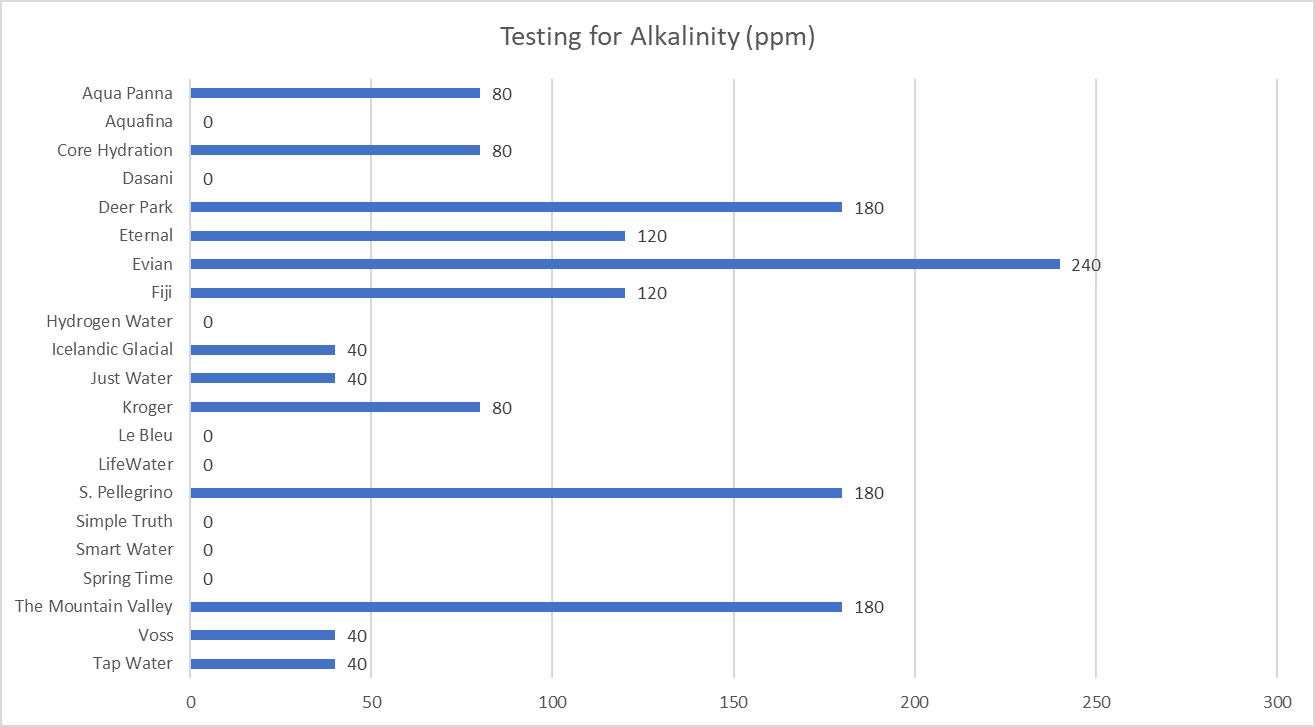

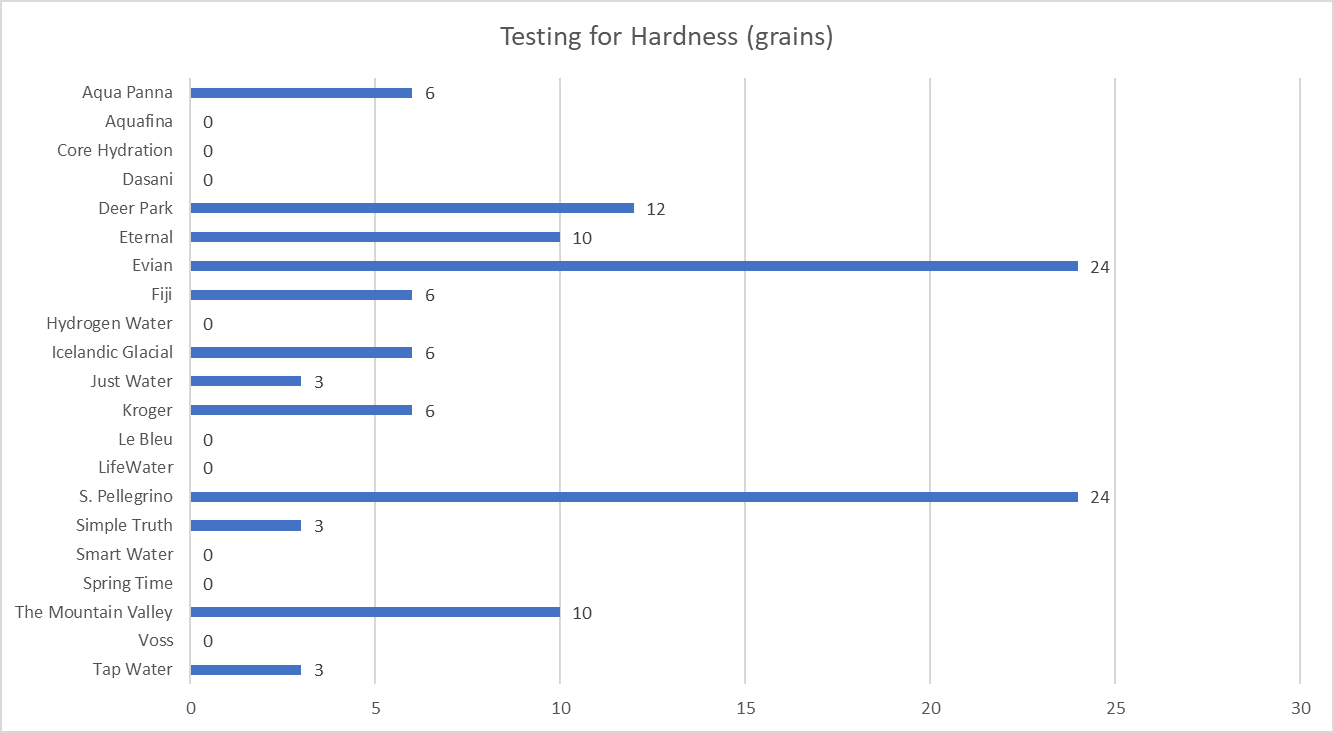
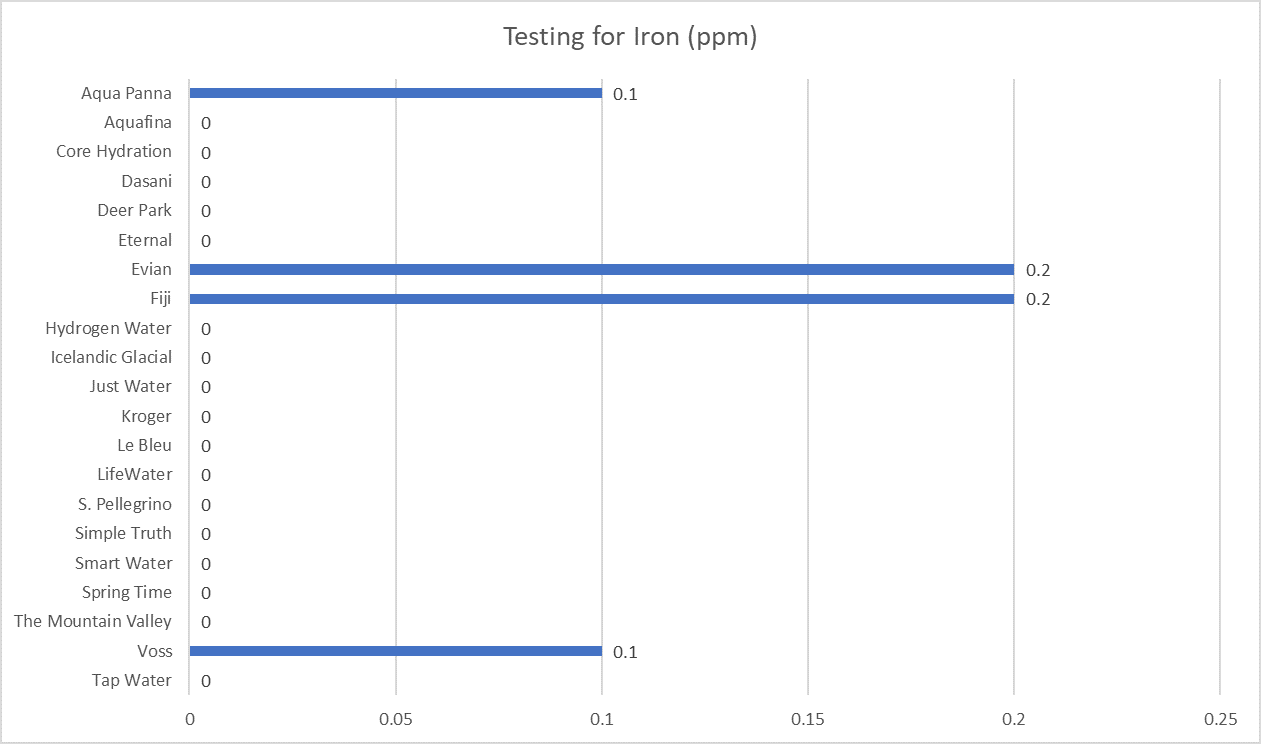
TDS Testing
The final testing we did was to check the bottled waters for total dissolved solids, using a TDS meter. The amount of total dissolved solids is a measurement of the weight of all solids that are dissolved in the water. These solids can include minerals, salts, metals, cations, or anions. Dissolved ionized solids can increase the conductivity of a solution. The TDS meter works by measuring the conductivity of the solution. The conductivity reading is then converted into an estimate of the TDS. This number is an indication of water quality. A high TDS reading doesn’t necessarily mean that water quality is poor, as it also reflects the amount of minerals and salts that are present in the water. These are found naturally in some waters. Manufacturers sometimes add minerals to purified water to improve the taste.
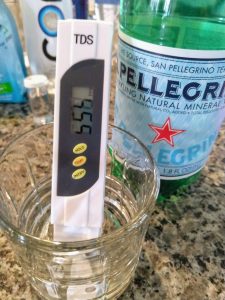
The results of the TDS test were all over the board. The most noteworthy were the bottled waters with the highest and lowest readings. San Pellegrino had the highest TDS reading at 564 ppm. This wasn’t surprising since that brand touts its high mineral content. At the other end of the spectrum was Le Bleu which was the only brand to have a 0 ppm TDS reading. Again, not surprising since this brand advertised a five-step ultrafiltration process. Unfortunately, we found that left the water with a terrible taste.
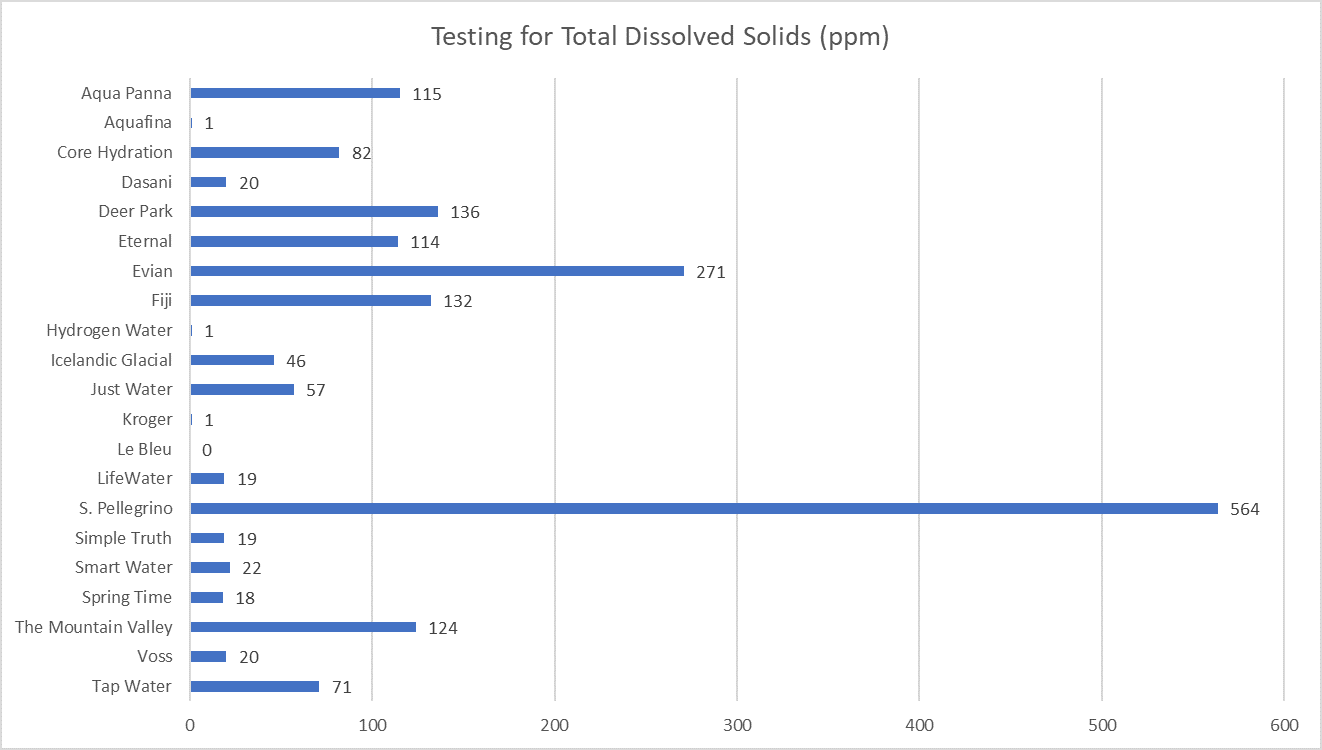
Winners
So, which bottled water is best? That depends on what you are looking for. What we found is that there is a bottled water that satisfies just about anything you could want in a water. Here are the winners (and losers) as we see them:
| Brand | Awards |
|---|---|
| Evian | Most alkaline |
| Hydrogen Water | Most claims for improving health and performance Most awkward bottle |
| Just Water | Most environmentally friendly packaging |
| Le Bleu | Purest Worst tasting |
| San Pellegrino | Highest TDS |
| Tap Water | Most chlorine Most nitrates |
Some people like the carbonation of sparkling water, while others hate the extra earthiness of mineral waters. Still, others prefer the predictable neutral taste of filtered water. Ultimately, which bottled water you choose depends on your personal tastes and preferences.
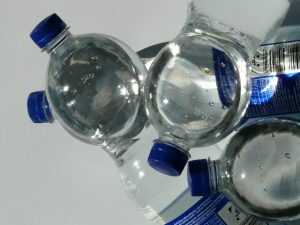
Testing code for colors. This is an example of white text. While white is nice, it is not readable. Testing code for colors. This is an example of white text. While white is nice, it is not readable. Testing code for colors. This is an example of white text. While white is nice, it is not readable. Testing code for colors. This is an example of white text. While white is nice, it is not readable. Testing code for colors. This is an example of white text. While white is nice, it is not readable. Testing code for colors. This is an example of white text. While white is nice, it is not readable. Testing code for colors. This is an example of white text. While white is nice, it is not readable.
Subheading Colors
Testing code for colors. This is an example of white text. While white is nice, it is not readable. Testing code for colors. This is an example of white text. While white is nice, it is not readable for colors. This is an example of white text. While white is nice, it is not readable. Testing code for colors. Testing code for colors. This is an example of white text. While white is nice, it is not readable. Testing code for colors. This is an example of white text. While white is nice, it is not readable. Testing code for colors. This is an example of white text. While white is nice, it is not readable. Testing code for colors. This is an example of white text. While white is nice, it is not readable.
Subheading Colors
Testing code for colors. This is an example of white text. While white is nice, it is not readable. Testing code for colors. This is an example of white text. While white is nice, it is not readable for colors. This is an example of white text. While white is nice, it is not readable. Testing code for colors. Testing code for colors. This is an example of white text. While white is nice, it is not readable. Testing code for colors. This is an example of white text. While white is nice, it is not readable. Testing code for colors. This is an example of white text. While white is nice, it is not readable. Testing code for colors. This is an example of white text. While white is nice, it is not readable.

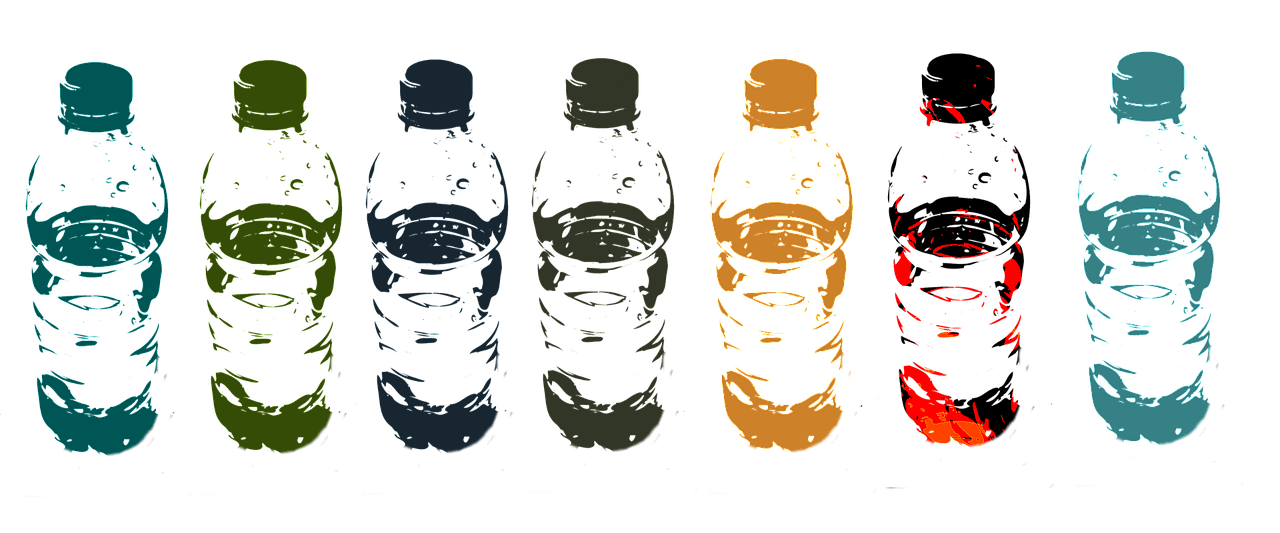
I know you’re aware of the Standard Methods for the Examination of Water and Wastewater book. So why in the world are you using a dodgy $7 ‘TDS meter’ which are typically calibrated for 1413 µs/cm?
Strips are only supposed to be used to give you a ball park figure and to check for extreme readings (high/low pH or chlorine/nitrite, etc).
I appreciate that you went to all this trouble, but your results would be more credible had you also compared them to that of a reputable lab.